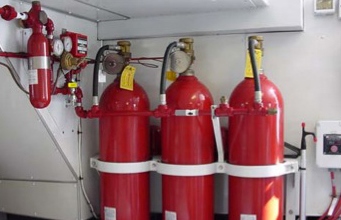Even routine testing and maintenance of carbon dioxide (C02) fire extinguishing systems can put mariners at risk, the Coast Guard says in a new safety alert.
Citing two recent examples, Coast Guard officials said their own marine inspectors were not only witnesses, but at risk along with crew members from accidental releases of the smothering gas.
“CO2 fire extinguishing systems present an inherent risk to the personnel involved with their inspection, testing, and maintenance. Over the years the Coast Guard has become aware of multiple events where these systems have inadvertently released or leaked and caused the deaths of shipboard personnel, technicians and inspection personnel,” states the safety alert, developed by the Coast Guard 13th District Marine Safety Unit in Portland, Ore.
“CO2 system inspection, testing, and maintenance require thoughtful planning and risk mitigation efforts to prevent such events from happening.”
In one case cited by the Coast Guard, a vessel’s chief mate and a Coast Guard Inspector were testing the fire detection system. In the vessel’s hydraulic equipment room, the mate stood on a spare parts box so he could apply a heat gun to a heat actuator.
“The CO2 subsequently discharged directly above their heads and filled the room,” according to the narrative. “The mate was overcome by the CO2 release and had to be revived by CPR (cardiopulmonary resuscitation) after being pulled out of the space unconscious.”
Investigators found that the accident was triggered by the mate applying heat an actuator, and not a heat temperature transmitter.
“The difference between these components is substantial. The detector is connected by wires to the monitoring system on the bridge while the release actuator directly connects to its local CO2 system through tubing,” according to the alert. “The heat actuator when heated creates a slight pressure in the tubing, immediately activating the pneumatic control head of the CO2 bottle, releasing CO2 into the space without delay or warning.”
Crewmembers were unfamiliar with the system and had not referred to its manuals, the Coast Guard determined, and so “their testing of the system was conducted without an understanding of the impacts of their actions, placing them and the Coast Guard inspectors at risk.”
In a second, unrelated incident, four Coast Guard inspectors were conduction a vessel inspection for certification while technicians were working on the CO2 system. One inspector in the machinery space was told the technicians were going to release the gas, which was not part of the planned inspection.
The system had been accidently primed for release when the pilot system was activated by a technician in training. As the technician was reconnecting the cable actuated release levers attached to the tops of the bottles, the activation cables remained connected to the levers.
When the bottles were moved later in the servicing process, the cable tension increased to the point where the levers were lifted, resulting in the release of charged bottles against a closed valve. That prevented an immediate release into the space.
The technicians finally decided they needed to release the entire engine room CO2 system to remedy the situation. They informed the vessel’s engineers, who performed an accountability check for all personnel in the space. But they missed one inspector who was still in the engine room.
Only after the inspector’s partner realized his associate was missing was another, more thorough sweep of the engine room made and the missing inspector found.
“Even after clearing the engine room the situation remained hazardous as various personnel stood by in the engine control room while the gas was released,” the report said. “After realizing the magnitude of the CO2 being released, the personnel in the control room evacuated to the vessel’s main deck and no further entry was made into the engine room until the fire department ruled it safe for human occupancy.
The alert cites lessons learned in those cases:
Only persons adequately trained and properly evaluated are permitted to participate in CO2 testing and maintenance procedures onboard vessels.
Every person involved must know and consider the resulting outcomes for each step of the testing procedure prior to it taking place.
Risks associated with CO2 and other systems should never be underestimated. Risk prevention activities should always lean towards providing the greatest safety margins for those involved including 100% accountability of all personnel aboard the vessel prior to conducting an operational test of a system.





